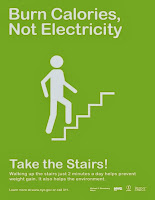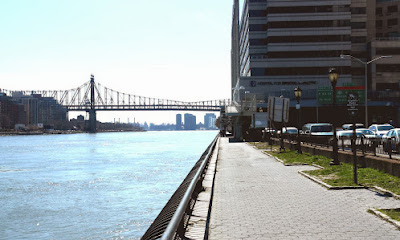Tali Cantor
 |
Pedestrian plaza at Madison Square, part of the Broadway Boulevard Project.
Photo by NYC Department of Transportation.
|
Although New York City is considered an active city compared to places with greater car use, the NYC Department of Health and Mental Hygiene (DOHMH) estimates that 80% of adults living in the city are still not maintaining the recommended 30 minutes of exercise at least 5 days a week. In fact, in NYC alone over half of adults are either obese or overweight. However you feel about the new blue additions to the city’s streets and sidewalks, CitiBike bicycle share is only one example of city efforts to improve New Yorkers’ health through physical activity.
Solutions to get New Yorkers moving, like the bicycle infrastructure, can be found through active design for the built environment. The DOHMH, and the Departments of Design and Construction, Transportation, and City Planning have promoted and implemented active design by encouraging physical activity indoors and in public spaces.
In 2010, these agencies released a report called Active Design Guidelines. This report provides an extensive resource for designers, property developers and owners, public officials, and community members to understand design strategies focused on increasing physical activity, as well as access to transportation, open space, and fresh food.
At the building level, active design recommends architecture that integrates physical activity into daily routines, particularly through stairwell design and pedestrian circulation. Improving the stairway experience may be as basic as adding color, light, or signage. Since 2008 the NYC “Burn Calories not Electricity” campaign has provided signs with this slogan on stairwell doorways to encourage stair rather than elevator use, and Mayor Bloomberg further promoted this message by announcing a series of legislative policies to require buildings to increase stairway visibility and
accessibility.
In the public realm, New York City has seen design interventions and programs to increase opportunities for active recreation outdoors. Street improvements providing protected bicycle lanes, such as those on First, Second and Columbus Avenues, and the CitiBike bicycle share program encourage a healthy and efficient alternative transit. In addition, parks and open spaces with recreational facilities such as basketball courts, walking tracks, or even fitness stations offer outdoor amenities to get in shape without a gym pass. In 2011, the Make NYC Your Gym campaign included free public fitness classes and activities in city parks and public spaces to further increase opportunities for physical activity, and this summer’s “ G o P a r k ” c a m p a i g n advertised passive and active r e c r e a t i o n opportunities in these spaces as well.
Providing access to the recommended “apple-a-day” has also been a priority for active designers. In the long term, active design sets out to fill “food deserts” with full-service grocery stores, or to use open spaces for greenmarkets and farm stands.
The active design tools that will have the greatest impact on New Yorkers, however, are those that foster a safe and pleasant environment at the streetscape level. In summer 2013, the agencies behind the Active Design Guidelines released a follow-up report called Active Design: Shaping the Sidewalk Experience, a resource for understanding policies and programs that enhance an active, lively, and pedestrian-friendly sidewalk.
The report is written for designers, policy makers, students, and community members who want to impact urban design for the public realm. It looks at the sidewalk as a physical space that not only protects pedestrians from vehicular traffic, but also stimulates economic development and social interactions between neighbors and friends. It identifies the “sidewalk room” as the space containing the ground plane, building wall, roadside plane, and the canopy, each of which is governed by zoning regulations that determine building scale, street furniture, lighting, trees, and curbside parking, to name just a few design elements, and create an environment that is visually interesting, connected within the street network, and safe.
The sidewalk environments on the Upper East Side and East Harlem can be evaluated on the interactive website www.walkscore.com, which quantifies neighborhood “walkability” based on factors such as population, public transportation, and proximity to local retail and amenities. Of the 256 neighborhoods identified in NYC, the Upper East Side is ranked 20th with a high walk score of 98 out of 100 and East Harlem is ranked 43rd with a score of 93. Within these neighborhoods, however, there exist significant physical obstacles that impede pedestrian accessibility, such as the FDR Drive that acts as a barrier between the residential neighborhoods to its west and the waterfront parks along the East River Esplanade. North of 97th Street, the MetroNorth train tracks along Park Avenue physically divide East Harlem and either prevent or limit access from one side of the avenue to the other. Where the tracks rise to allow pedestrian connections below, the amount of underutilized and vacant space detracts from a lively sidewalk.
The report includes a companion guide, which provides tools and resources to measure sidewalk success through qualitative and quantitative survey analysis, and an appendix of policies that are applicable to sidewalk design and function. For those non-designers, the city provides resources for community members to take ownership of the “sidewalk room.” This could be as easy as calling 311 to report hazardous sidewalk conditions or poorly maintained street furniture, to request street trees or benches, or else becoming more involved with the local Community Board or community-based organizations to raise concerns with like-minded neighbors.
Creating an optimal pedestrian environment is just one way to realize active design, and it facilitates the most basic and inexpensive type of exercise - using your own two feet. So this fall, get off the train a subway stop early or aim for that extra flight of stairs, and take advantage of all the opportunities to stay healthy that are built right into the city surrounding you.
NYC Recreational and Fitness Parks
 |
One of the various forms of exercise
on the East River Esplanade
|
Asphalt Green
From East 90 Street between York Avenue and FDR Drive
FE, P
John Jay Park
From East 76 to East 78th Streets at Cherokee Place
BC, FE, HB, OP, P
St. Catherine’s Park
From East 67th Street to East 68th Streets at 1st Avenue
BC, FE, HB, P, RT
Thomas Jefferson Park
Between 1st Avenue and FDR Drive From East 111th to East 114th Streets
BB, BF, FE, HB, OP, P, RC, RT, SF
BC - Basketball Courts
BF - Baseball Fields
FE - Fitness Equipment
HB - Handball Courts
OP - Outdoor Pools
P - Playgrounds
RC - Recreation Center
RT - Running Tracks
SF - Soccer Fields v
.png)















